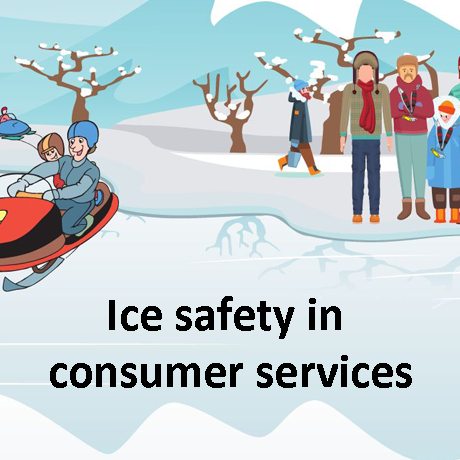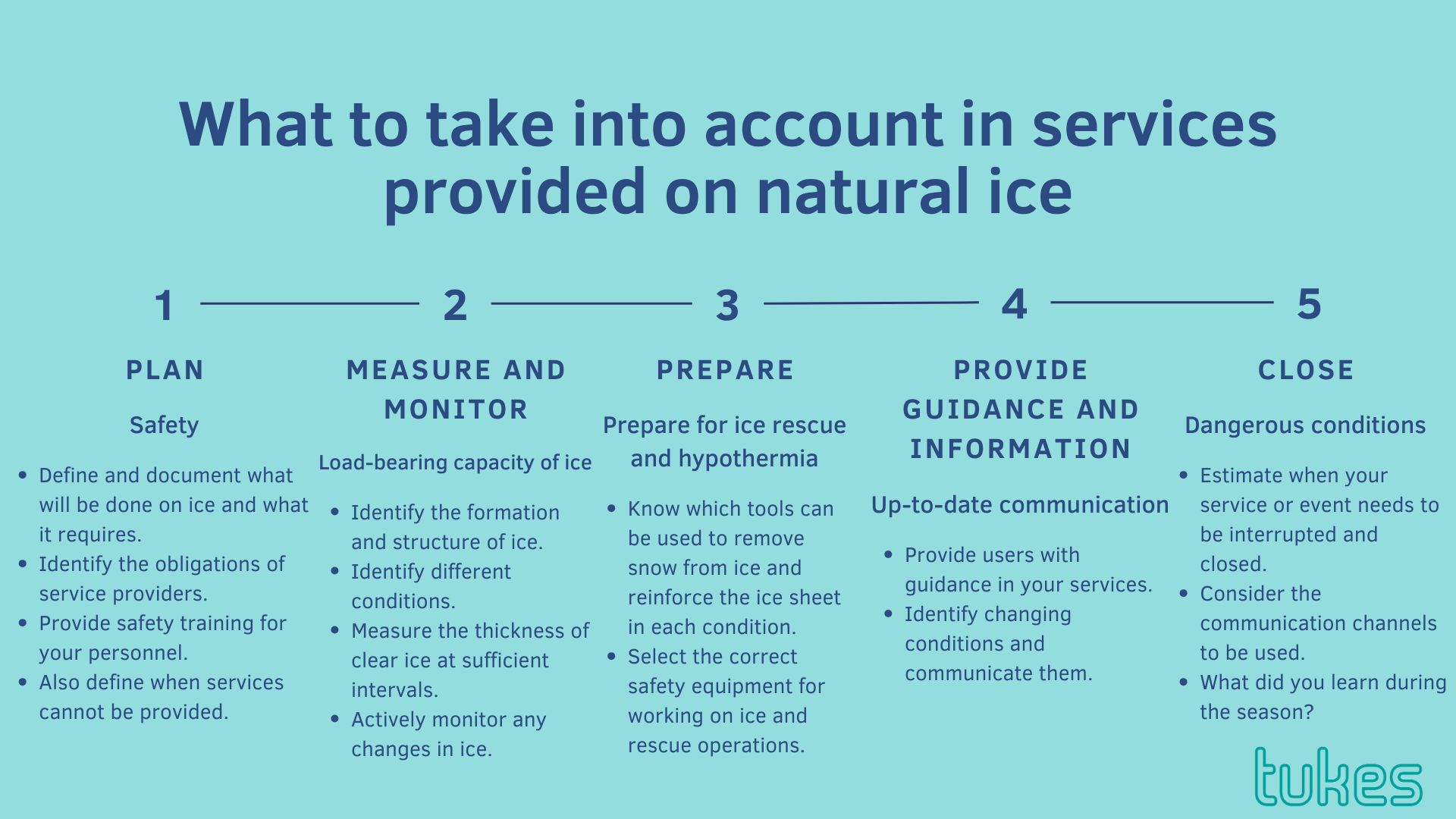Think ahead about the service or event you are about to provide, for whom and where
The following consumer services can be provided on natural ice:
- ice carousel, café, ice swimming, guided snowmobile safaris, and other programme services;
- ice fishing competitions, ice racing, ice trotting, and other public events;
- tour and Nordic skating, hiking routes on ice, and sledding hills and ski slopes that extend to natural ice, and other sports services.
The Consumer Safety Act (920/2011) applies to all of the aforementioned services. By law, it is irrelevant whether a service or event carries a fee or is free of charge.
Companies and other parties engaged in business activities that provide the aforementioned services and events are regarded as service providers. The Consumer Safety Act does not apply to private individuals when they are not engaged in business activities or associations when they only provide activities for their own members. Furthermore, the Consumer Safety Act does not apply to private individuals’ own activities on ice based on the freedom to roam.
How to get started?
Service providers must ensure that their services comply with the Consumer Safety Act. Service providers must ensure that their services do not present any risks or hazards to customers or third parties.
Customers of services provided on ice can range from experienced hikers who can identify different ice conditions to individuals who have no prior experience in being on ice. Service providers must ensure that their services are safe for all types of customers.
Service providers cannot have any impact on natural conditions or guarantee that services held outdoors are always available. However, service providers must take various available means to ensure that their services are always safe when they are available to customers. Service providers must ensure, by means of communication, for example, that their services are not used when conditions are unsafe.

The requirements set out in the Consumer Safety Act for service providers are described in more detail on the Tukes website. More information about the safety of public events is available under Public events on the Tukes website. Also, read the Järki jäällä (Be smart on ice) guide of the Finnish Swimming Teaching and Lifesaving Federation and the report on occupational and customer safety in natural ice conditions of VTT Technical Research Centre of Finland.
Selecting the ice area
Only provide services or events in such ice areas that you are familiar with and that you know are safe.
Providing services on ice is not safe until the thickness of clear ice in measuring points is at least 10 cm over the entire area in which services are to be provided. Most services require an even thicker sheet of clear ice. The thickness of clear ice required for each service or event must be assessed separately considering the nature of the service or event, the number of spectators and the special characteristics of the ice area (see measure and monitor the load-bearing capacity of ice).
Ensure beforehand whether the service or event to be provided on ice requires a permission from the owner of the land and water area. Cooperate with the owner of the land and water area to ensure ice safety. For example, the landowner may have prior information about the quality of ice and any changes in it, or information about the best routes to access the ice area. Report any findings or deviations to the owner of the area.
When selecting the ice area and making arrangements, also note people living next to the waterbody, fishers and other users of the water area. Communicate and cooperate openly to ensure that your services do not cause any unreasonable harm.
Ensure the load-bearing capacity of ice in the selected area by conducting sufficiently extensive measurements at several measuring points (see measure and monitor the load-bearing capacity of ice). More information about general hazards in ice areas is available in the Järki jäällä (Be smart on ice) guide of the Finnish Swimming Teaching and Lifesaving Federation.
Services must be safe throughout their provision for customers. Especially during early winter and late spring, ensure that the load-bearing capacity of ice is sufficient for the service in question. Notify customers actively of any interruptions and restrictions in services (see Guidance and notifications).
Identifying hazards and entering them in the safety document
Identify the hazards related to your service or event in great detail. Take note of any locations that are dangerous for customers or determine the hazards customers may face during different phases of your service (e.g. hazards caused by heavy-duty machinery operated on ice, collisions between those moving around on ice, etc.).
Identify hazards throughout the area in which customers move around on ice (e.g. the route through which customers access the service or event, any areas in which customers may accidentally access areas outside the supervised ice area, any areas in which the ice sheet is often thin due to flowing water, etc.).
Consider what measures can be taken to eliminate the identified hazards or at least to minimise the probability of injuries and accidents. Put your planned measures into practice.
Make a note in the safety document of the practical measures you have taken to ensure the safety of customers. For services provided on ice, the measurements and other measures conducted to ensure the load-bearing capacity of ice must be entered in great detail in the safety document (see Measure and monitor the load-bearing capacity of ice), as well as preparations for rescuing any persons who have fallen through ice and the related skills required (see Prepare for ice rescue), and the measures required to notify customers of ice safety (see Guidance and notifications).
Further information and forms to help identify hazards and prepare a safety document are available on the Tukes website.
Safety training
Service providers must have sufficient training, experience and competence to provide their service safely. The group of people participating in the provision of a service or event must include a sufficient number of individuals who are able to guide, help and rescue customers in ice conditions. For the competence of the personnel concerning safety, it is important to practise how to act in different kinds of emergencies and accidents.

